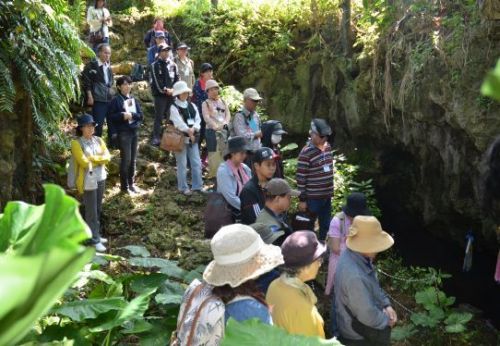Descendants of the Himeyuri Peace Corps visit the battlefield where the student nurses were mobilized for the 30-year anniversary of the Himeyuri Peace Museum

Descendants of the Himeyuri Peace Corps visiting the Ihara First Surgery Trench as part of the field work held by the Himeyuri Peace Museum. April 6, Ihara, Itoman
April 7, 2019 Ryukyu Shimpo
By Chikako Maemori
The Himeyuri Peace Museum in Itoman conducted field work at the battlefield that contained many of the casualties from the “Himeyuri Student Corps,” a corps of students that were mobilized to meet the need for medics during the Battle of Okinawa, alongside descendants of the student corps April 6.
As part of the 30-year anniversary of the opening of the museum, this is the first time the descendants have visited the site of the late World War II battlefield. There were 55 descendants in attendance, with ages ranging from 11 to 90 years old.
Following in their footsteps, they familiarized themselves with the area and thought about the family members they had lost.
The Himeyuri Students corps were comprised of female students from the Okinawa Shihan Women’s School and Okinawa Daiichi Women’s High School, and were led by their teachers during the Battle of Okinawa. Of the 240 women mobilized at the Okinawa Army Hospital, 136 were casualties. In addition, another 91 students from the two schools not included in the corps were also killed during the battle.
The field work on April 6 began at the location of the Shihan and Daiichi schoolhouses in Asato, Naha. The group traveled by bus on a route that stuck as close as possible to the route walked by the students after they were ordered to mobilize on March 23, 1945, ending at the remains of the Okinawa Army Hospital in Haebaru.
The group also visited Itokazu Abuchiragama in Tamagusuku, Nanjo, where the students were also mobilized.
“Do you know why the rock has turned black? It was scorched by the U.S. army’s assault.” At Abuchiragama, the voice of the museum’s guide, Akiko Nakata, could be heard echoing. In the dark cave, the descendants strained their eyes, headlamps affixed atop their heads.
In the afternoon, they met with five former students at the Himeyuri Peace Museum. In her opening remarks, Tomoka Futenma said, “I want to faithfully take the thoughts and experiences of both those who lived through this episode as well those who survived them, and continue to teach the importance of peace to many people from here on.”
From the participants, there were comments and questions for the former students such as, “I want to know what kind of people my relatives were,” and, “How did you do things like surgery in a cave as dark as that?”
Tsuru Motomura, 93, who was in her second year at Shihan when she was mobilized, said that since the completion of the museum she had been back to the battle site, but had not met with the families of the deceased.
“The things we were not able to do ourselves, were done by the next generation whom we entrusted these things to. Today, I am very thankful to be able to meet everyone.”
(English translation by T&CT and Sam Grieb)
Previous Article:Government’s broken promise not to store missiles on base unravels locals’ condition for accepting GSDF deployment
Next Article:No-war pledge: families bereaved by mass suicide hold memorial service
[Similar Articles]
- Himeyuri Peace Museum plans second renewal after first in 2004 with new exhibits to pass down history
- Former Himeyuri student delivers final lecture at museum
- After telling their story for 30 years, the Himeyuri Student Corps storytellers, now in their 90’s, to pass the baton to the post-war generation
- Picture books about Himeyuri and Zuisen students published
- Haebaru Junior High School students learn about the ravages of war in order to become peace tour guides.
 Webcam(Kokusai Street)
Webcam(Kokusai Street)


